In honor of its 75th anniversary
I am doing a multi-part story on
the national archives
Part 1 The story starts with the placement
of the Declaration of Independence
1. Heeding the advice
of Secretary of State Charles Evan Hughes, President Warren G.
Harding issued an order that transferred the custody of the Declaration
of Independence from the State Dept. to the Library of Congress
on September 29, 1921.
2. The parchment was taken out of a safe, placed in a mail truck,
driven to the Library of Congress, and locked in another safe.
3. Within a few months Congress funded a shrine for the Declaration
and Constitution in the Library's Great Hall.
4. On Feb. 28, 1924 President and Mrs. Calvin Coolidge dedicated
the shrine.
5. During World War II (1941-44)the Documents were store at Fort
Knox, Kentucky.
6. After the war the Declaration and the Constitution wer returned
to their shrine in the Library of Congress.
7. In 1951 the documents were sealed within an inert helium gas
environment inspecial glas and bronze cases.
8. On Dec. 13, 1952 the cases were moved to their present home
n the National Archives building. |
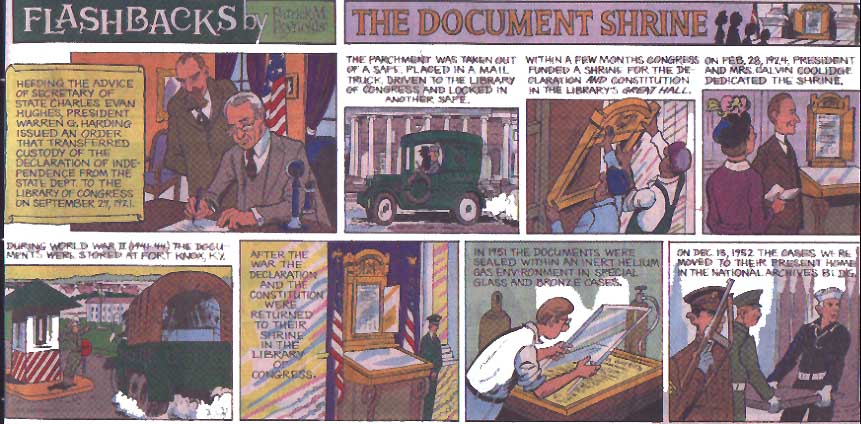
Part 2
1. Established in 1934,
the National Archives consists of this beautiful building on
Constitution Ave in Washington, DC, plus regional centers and
Presidential Libraries.
All together the Archives holds hundreds of thousands of microfilm
and microfiche, and over 10½ million photos.
2. The question is--how were federal documents and records kept
before 1934?
3. When the United States of America was founded in 1776, the
government's documents traveled with Congress Between 1776 and
1800 the government moved eleven times.
4. For the next 134 years each federal agency stored its own
records in hallways, offices, attics, basements, and garages.
5. Sometimes the buildings caught fire and many documents and
records were lost.
6. As early as the 1830s President Andrew Jackson prodded Congress,
"We need a fireproof building for important books and papers."
Nothing was done. |
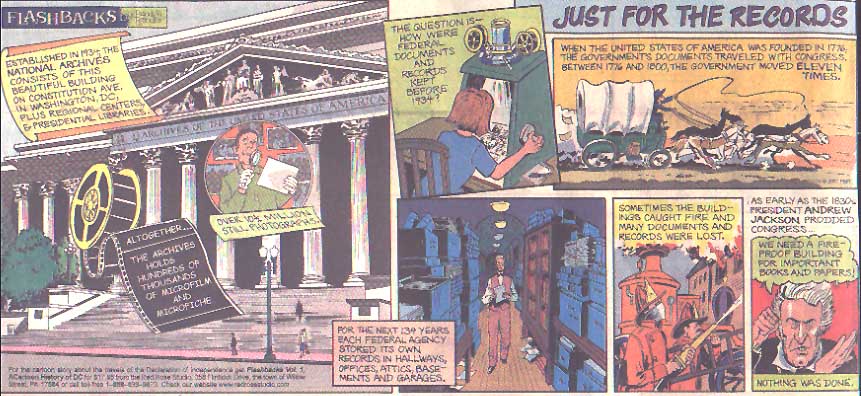
Part 3
1. There was no safe
way to secure and preserve America's documents and records before
1934.
Collectors stole many valuable documents.
2. A thief used a razor to remove the signature of such notables
as John C. Calhoun, Henry Clay, and John Quincy Adams.
3. One government sold 400 tons of documents for scrap....
4. To ake room for his office.
5. Montgomery Meigs, Quartermaster General of the Army in 1878,
advised President Rutherford B. Hayes, " A cheap fireproof
building should be constructed as a Hall of Records." Harrison:
"Good idea."
6. Fort-two archives bills were introduced in the House andSenate
between 1881 and 1912.
Unknown congressman: "The Government can't afford
it."
7. Then, in 1921 a fire in the Comerce Department destroyed the
census records dating back to 1790.
8. This sparked scholars, the American Legion, and Hearst Newspapers
to pressure Congress for a National Archives. Congressman,
"Yes, I'll vote for an Archives."
9. In 1926 Congress appropriated $6.9 million for a National
Archives and commissioned John Russell Pope to design the building.
The National Archives at Constitution Avenue and 8th Street opend
to the public in 1934. |
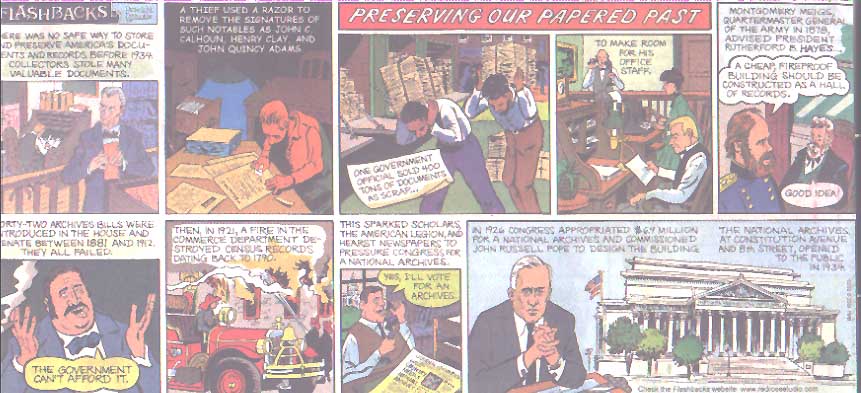
Part 4
1. Famous for its magnificent
display of the Declaration of Independence and the Bill of Rights
in this edivice on Constitution Avenue, the National Archives
collects and preserves billions of documents from every agency
in the federal government. There are many Archives facilities
across the U.S.
2. Important "treasures" in the Archives include the
Instruments of Surrender signed by the Japanese on September
2,1945 aboard the battleship U.S.S. Missouri,
3. Manifests of slave ships, the Emancipation Proclamation,
4. hand-written journals of polar expeditions, and...
5. the Louisiana Purchase Treaty bearing the signature "Bonaparte."
6. Prior to 1934 there was no uniform system for storing and
preserving government documents. |
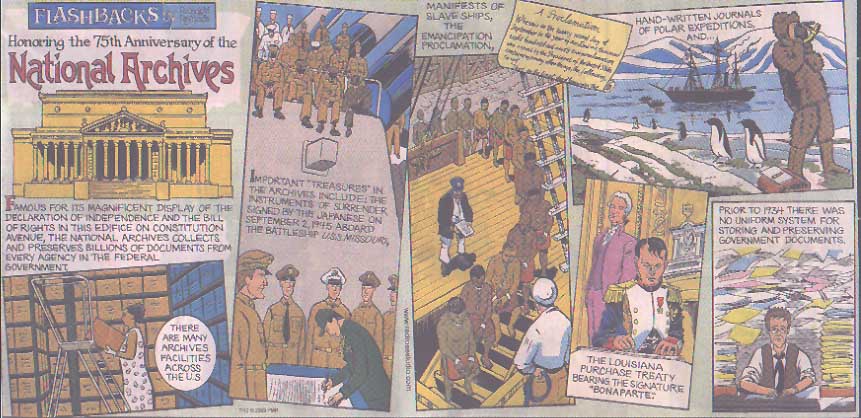
Part 5 Cramped Quarters
1. By the 1920s the federal
government had grown so much that it was running out of office
space.
2. Congress passed the Public Buildings Act of May 25, 1926 which
doled out $338 million for 327 construction projects from federal
buildings to post offices across the country.
3. Meanwhile, J. Franklin Jameson had been a prominent member
of the American Historical Association and the driving force
behind the lobbying effort to establish a National Archives.
On March 31, 1930 Congress upped the appropriation to $568 million
with $8.5 million set aside to erect the National Archives.
4. Ground was broken for the Archives building on September 9,
1931, but progress was slow because the site on Constitution
Avenue was a swamp with an underground creek. Workers had to
drive 8,575 pilings as deep as 21 feet to stabilize the structure. |
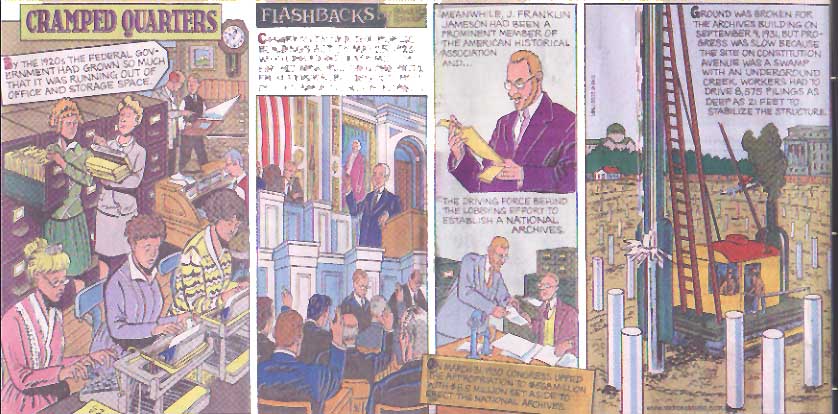
Part 6 Something to Remember Me By
1. Blamed for the Great Depression,
President Herbert Hoover lost his run for reelection in 1932.
2. Hoover wanted to go out on a positive note.
3. As his limo passes the construction site of the National
Archives, Hoover says, "My name should be on the cornerstone
of the National Archives."
4. He ordered his aides to set up a ceremony. An aide reports,
"But Mr. President, the engineers say the building is not
at the stage where it can bear the weight of a cornerstone."
Hoover: "Nonsense!"
5. Hoover: "I, too, am an engineer. Tell them to do it NOW!"
6. Workers quickly erected a special platform for the ceremony.
7. On February 20, 1933, just twelve days before he was to leave
office, President Hoover presided over the ceremony for laying
the cornerstone of the National Archives building.
Among the cornerstone's contents were: a Bible, copies of the
Declaration of Independence and the Constitution, an American
flag, and other significant items. |
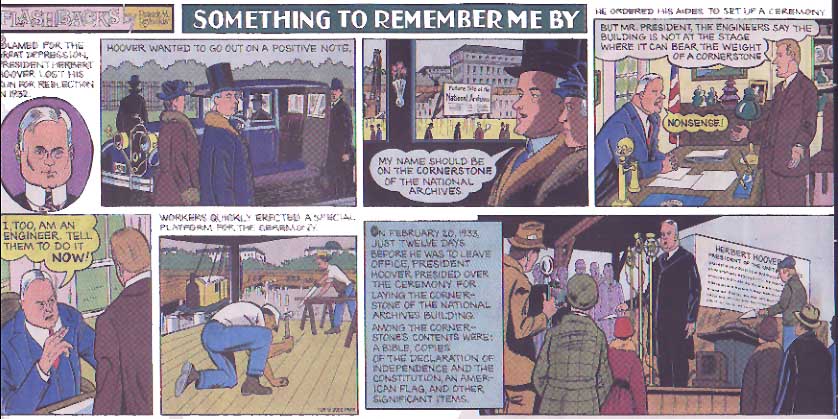
Part 7 Not Ready for
Occupancy
1. On June 19,1934 President Franklin Delano Roosevelt signed
the bill that created the National Archives as an independent
agency to preserve government records "in a manner useful
to both the government and the public."
2. Meanwhile the George A. Fuller Company was far from completing
the archives building. Awarded in 1932 their contract specified
completion within two years at a cost of $5 million.
3. On October 10, 1934 FDR appointed Robert Digges Wimberly Connor
as the first archivist of the U.S.
Dr. Connor had been a history professor at the University of
North Carolina and the state's archivist from 1913 to 1921.
4. The National Archvies building was not ready for occupancy,
so Connor and his staff worked the the Justice building across
the street. With FDR's full support, Connor made several major
changes to architect John Russel Pope's (right( design.
Connor: "Cancel the center courtyard. That should make room
for more storage space."
Pope: "We should add an extension."
5. The Archives building was occupiedon November 8, 1935. The
extension was completed in 1937. The final cost was $12 million. |
Part 8 Findings
1. As Archivist of the U.S., Professor R.D.W. Connor's first
task was to persuade government officials to hand over all their
old files to the National Archives.
Department head, "My department's records go back
150 years. They're stored all over the city."
Connor, "My people will start searching immediately."
2. Connor gave annual reports to Congress. On January 2, 1939
he stated, "Since 1935 we found 2,699,561 cubic feet of
paper records...
3. "That have been kept in 6,492 'depositories' in or near
the District of Columbia in such places as cramped garages, musty
attics, and damp cellars.
4. "2,346,598 still photo negatives were located, including
many glass negatives from the Civil War.
5. "Lastly, out staff collected 5,495 sound recordings.
6. "At least a third of everything we examined was damaged
by dust, filth, water, theft, mold, or vermin." |
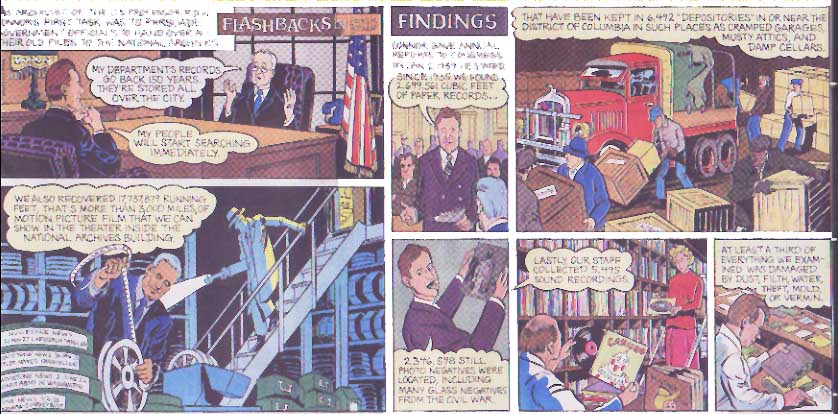
Part 9 Dusting and
Debugging
1. Truck convoys began delivering tons of documents to the National
Archives in June 1936. The first 58,500 cubic feet of records
came mostly from the Veterans Administration and the U.S. Food
Administration.
2. Before being brought into the storage area, the records had
to be thoroughly cleaned and fumigated.
3. First came the dusting. Archivists designed an air gun which
blew the dust and debris through a bronze screen ona special
table. The dust is drawn by air current through the screen then
filtered from the air. The clean air is forced outside.
4. Next, workers pushed the records into a "vacuum chamber,"
where...
5. Paper-chomping bugs and other creepy-crawlies were "fumigated."
6. Inside the building, clerks unrolled, unfolded, and flattened
thousands of maps and other documents. |
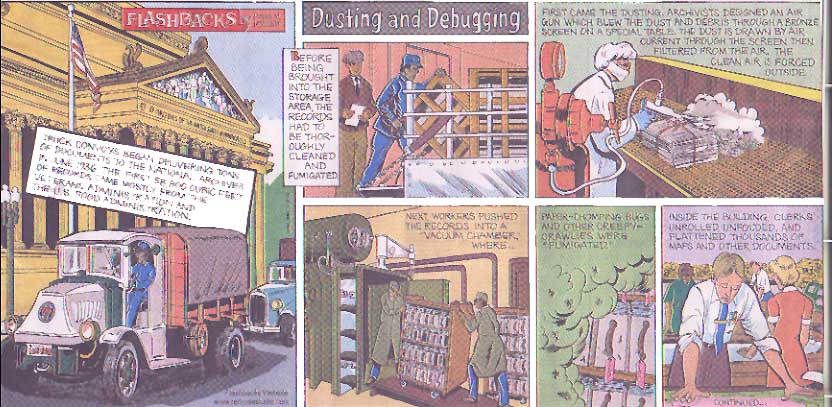
Reference came from several news items that appeared in old magazines
and newsapers. We are not aware of any particular book that contains
all of this information. |







